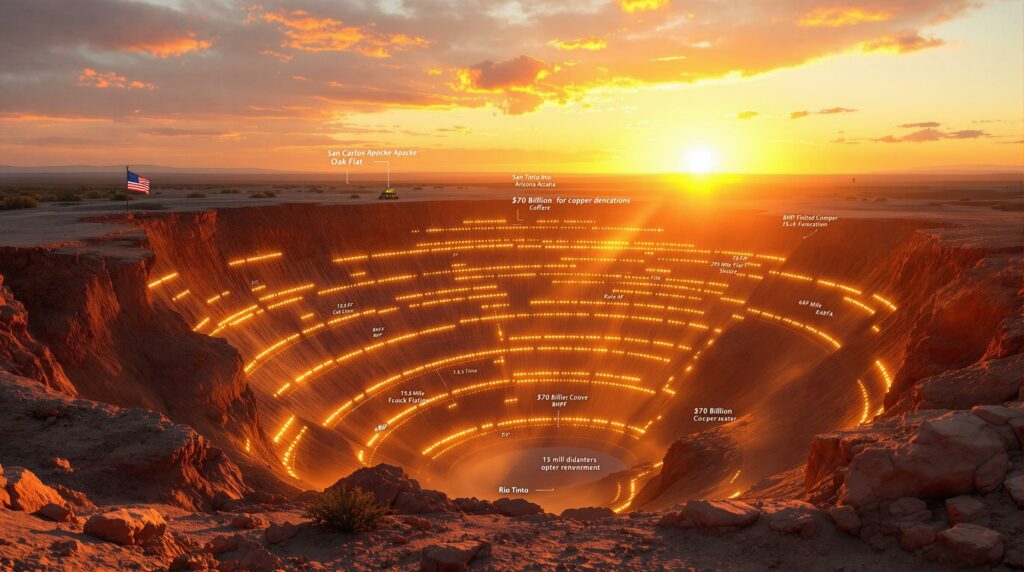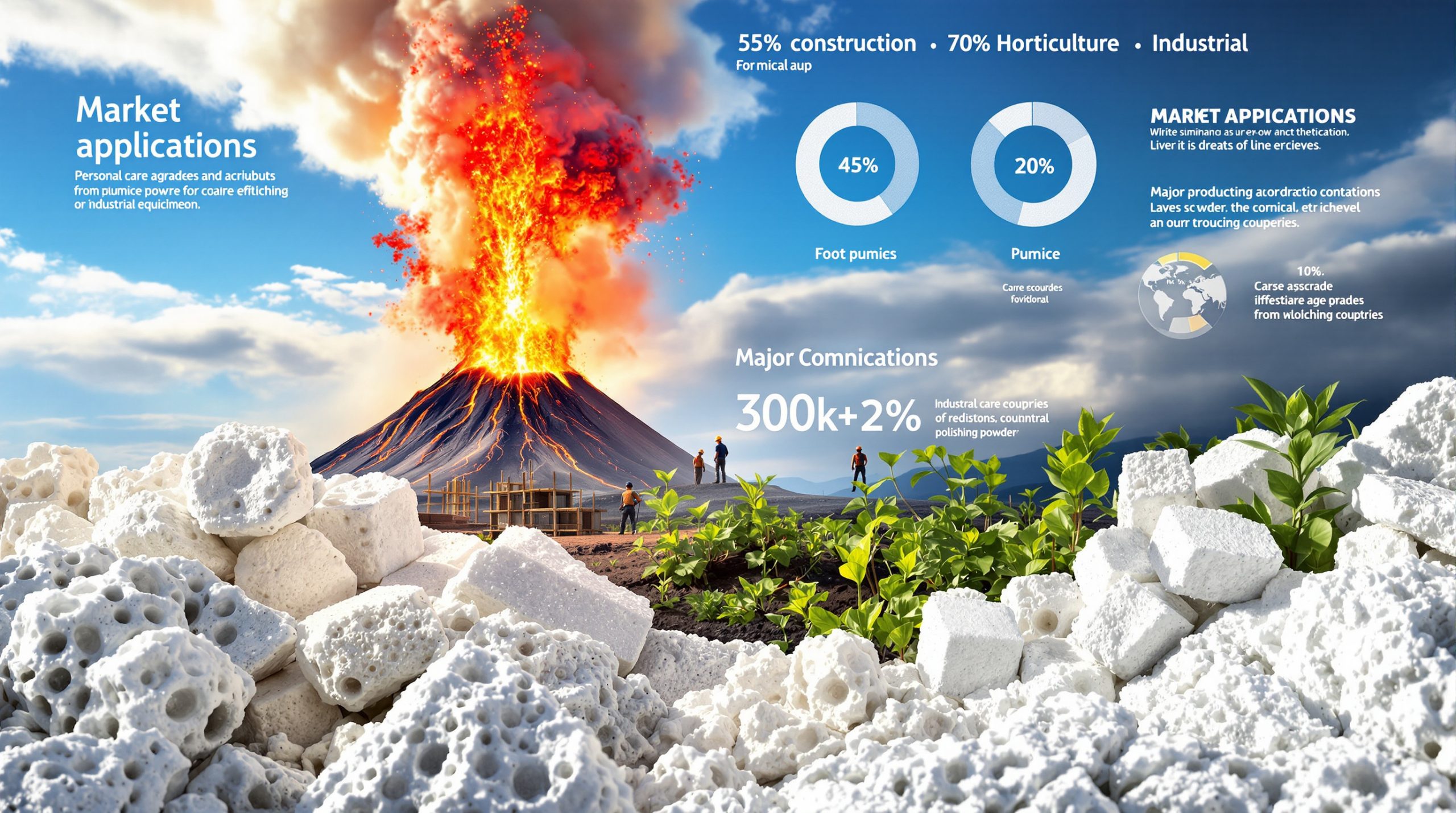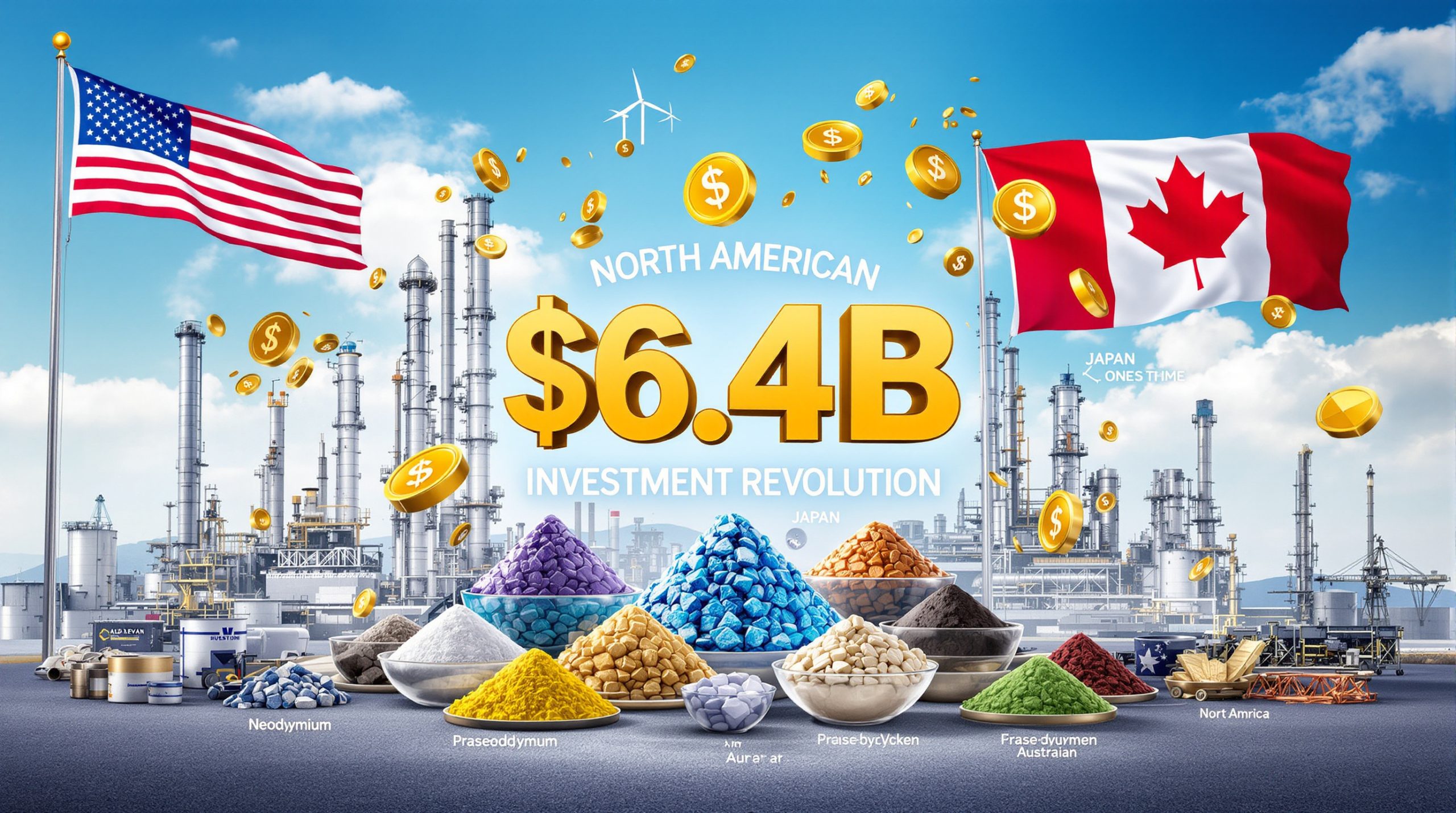Resolution Copper: America's Largest Untapped Copper Deposit Progressing Toward Reality
America's largest untapped copper mine in Arizona represents a critical opportunity for the United States to establish domestic supply security for this essential metal. Hidden beneath the Arizona desert, Resolution Copper is steadily advancing despite significant challenges, with potential production still years away but promising tremendous economic impact.
What Is Resolution Copper and Why Does It Matter?
Resolution Copper represents a colossal mineral resource of unprecedented scale in the United States. This massive underground deposit contains an estimated 28 million metric tons of copper in reserve and resource—valued at approximately $270 billion at current market prices. Once operational, the project could supply roughly 25% of America's domestic copper needs, making it a cornerstone of national resource security.
The timing couldn't be more critical as the United States works to reduce dependence on foreign copper sources amid surging demand. Copper serves as the fundamental building block for renewable energy infrastructure, electric vehicles, and advanced manufacturing—all sectors experiencing explosive growth as the global economy transitions to greener technologies.
The Strategic Importance in America's Copper Renaissance
As Gracelin Baskaran, director of the critical minerals security program at the Center for Strategic and International Studies, notes: "We're at a point where mining companies are very hesitant to mine in the US because of the long permitting and litigation times. Seeing a project like Resolution enter production would be an important signal to the mining sector."
This hesitancy is reflected in troubling statistics—according to S&P Global, the average timeline between discovery and commercial production for U.S. mines stretches to 29 years, the second-longest globally after Zambia. Resolution's eventual success could help reverse this trend, potentially catalyzing other domestic copper investment trends critical to America's industrial future.
How Deep Is the Resolution Copper Mine?
The Extreme Engineering Challenge
The Resolution copper deposit lies at extraordinary depths, requiring miners to descend more than a mile underground via a steel cage—a journey taking approximately 15 minutes each way. This makes Resolution one of the deepest mining operations in North America, pushing the boundaries of what's technically possible in underground resource extraction.
The extreme depth presents unprecedented engineering challenges that would have been insurmountable just decades ago. Modern mining technology has made accessing these depths commercially viable for the first time, including advanced cooling systems, automated equipment, and sophisticated ventilation networks.
Dealing with Extreme Underground Conditions
At these depths, temperatures reach a blistering 175°F (79°C), creating conditions that would be lethal without extensive intervention. Massive cooling units run constantly, generating a pervasive mist throughout the tunnels. This condensation drips continuously from tunnel ceilings and progressively calcifies the pipes lining the walls.
Before recent cooling system expansions, workers could only remain underground for approximately one hour before needing to return to the surface—a severe limitation on productivity. These challenging conditions have necessitated innovative approaches to worker safety, equipment design, and operational planning that go far beyond conventional mining practices.
Who Owns the Resolution Copper Project?
The Mining Giants Behind the Project
Resolution Copper operates as a joint venture between two of the world's largest mining conglomerates—Rio Tinto Group and BHP Group. These global mining powerhouses bring extensive experience, technical expertise, and financial resources essential for a project of this magnitude.
The companies have demonstrated extraordinary patience and commitment, having invested over $2 billion in the project across two decades without extracting a single ounce of copper for commercial purposes. This long-term vision reflects both the exceptional value of the deposit and the companies' understanding of the extended timelines typical for major copper system analysis in the United States.
Investment and Development Timeline
The project's footprint includes approximately 2,400 acres of public land designated by Congress for the mining operation. Despite substantial financial commitment and extensive underground development work, including thorough mapping of the ore body and construction of one of America's deepest mining shafts, actual production remains years away.
This extended timeline illustrates the complexity of developing world-class mining projects in the modern regulatory environment, where environmental, cultural, and technical considerations must be carefully balanced with economic objectives.
What Obstacles Is Resolution Copper Facing?
Regulatory and Permitting Challenges
Resolution Copper faces a labyrinthine regulatory process spanning multiple government agencies at both state and federal levels. The project still awaits state air and groundwater permits, approval of its mine reclamation plan, and various federal authorizations.
The Trump administration has estimated the project will receive all necessary federal permits by February 2026—representing more than a decade in the permitting process alone. This extended timeline highlights the regulatory complexity surrounding major mining projects in the United States, which has become a significant deterrent to domestic mineral development.
Tribal Opposition and Sacred Land Concerns
Perhaps the most emotionally charged challenge comes from the San Carlos Apache Tribe, whose reservation lies approximately 70 miles from the project site. The tribe considers Oak Flat, which falls within the project's footprint, a sacred site of profound cultural and spiritual significance.
For centuries, the Apache have used this area for religious ceremonies, coming-of-age rites, prayer circles, and healing rituals. The land also contains burial sites, petroglyphs, and ancient cultural artifacts that represent irreplaceable connections to tribal heritage and identity.
Environmental Concerns and Legal Battles
Environmental advocacy groups, including the Arizona Mining Reform Coalition, have raised significant concerns about the project's water usage during Arizona's severe drought conditions and the permanent alteration of recreational areas valued by local communities.
As Roger Featherstone, director emeritus of the Arizona Mining Reform Coalition, succinctly states: "Bottom line—the project is not worth the risk any way you look at it." The U.S. Forest Service has estimated that 41 years of mining would create a surface crater approximately 1.8 miles in diameter and up to 1,115 feet deep, permanently transforming the landscape.
How Is the Block-Caving Mining Method Being Implemented?
The Technical Approach to Extracting Deep Copper
Resolution Copper plans to employ block-caving, an advanced underground mining technique particularly suited to large, deep ore bodies. This method involves creating an extensive network of tunnels beneath the ore deposit, then strategically detonating explosives to fracture the ore. The fractured material then collapses downward through gravity, allowing for efficient collection.
This approach requires massive upfront investment in infrastructure and years of preparatory development work before production can begin. However, once operational, block-caving can be more economically efficient and environmentally preferable to open-pit mining for accessing deep deposits like Resolution.
Evolution of Mining Techniques
The technological sophistication of Resolution Copper stands in stark contrast to historical mining methods used in the region. The historic Magma mine, which connects to Resolution, operated for 86 years until 1996 using far more primitive and dangerous techniques.
AJ Quiroz, a third-generation miner who has worked at Resolution since 2008, provides perspective on the dramatic evolution in mining conditions. He describes how miners previously extracted ore with pickaxes in caverns cleared by dynamite, often in "horrible" conditions with minimal safety equipment—a stark contrast to today's heavily engineered, technology-driven approach.
What Recent Legal Developments Impact the Project?
Supreme Court Decision on Apache Claims
In May 2025, the U.S. Supreme Court declined to hear the San Carlos Apache Tribe's petition seeking to block the transfer of land to Rio Tinto and BHP. This decision represented a significant procedural victory for the mining companies, though it did not resolve all outstanding legal challenges.
The decision marked an important milestone in the project's long regulatory journey but highlighted the ongoing tension between resource development, tribal sovereignty, and cultural preservation that characterizes many modern mining projects in the American West.
Land Transfer Timeline and Next Steps
If current legal challenges prove unsuccessful, the mining companies could obtain the land as early as mid-August 2025. This transfer would allow them to proceed with critical development work, including:
- Digging additional tunnels to reach the ore body
- Installing expanded ventilation systems
- Draining groundwater from the mining area
- Enhancing cooling, electrical, and communications infrastructure
Even with these advances, significant work would remain before commercial production could begin, reflecting the extraordinary complexity of developing deep underground resources.
What Economic and Industry Factors Will Influence Resolution's Success?
Processing Challenges and Tariff Considerations
Once operational, Resolution will face significant challenges related to processing costs in the United States. With limited domestic copper refining capacity, much U.S.-produced copper is currently shipped overseas for processing—creating logistical complexity and additional costs.
Recent policy developments have complicated the economic landscape. President Trump's July 30, 2025 decision to exempt refined copper imports from tariffs was viewed as a setback for domestic producers. However, his administration's concurrent efforts to expedite permitting for Resolution Copper demonstrate the project's strategic importance to national industrial policy.
Industry Support and Manufacturing Interests
The National Association of Manufacturers has publicly backed Resolution Copper, stating in a July 31, 2025 letter to U.S. regulators that the project would "help strengthen the US industrial base and reduce the need to export raw materials for processing overseas." This endorsement highlights the project's potential contribution to industrial revitalization and supply chain security.
The broader copper industry faces significant supply challenges that Resolution could help address. According to copper price insights from CRU Group, the global copper sector requires approximately $130 billion in investment over the next decade to address a projected annual supply shortfall of 7.5 million tons—making projects like Resolution increasingly important to global industrial capacity.
When Will Resolution Copper Begin Production?
Production Timeline and Future Prospects
Despite extensive development work and recent regulatory progress, commercial production at Resolution Copper remains distant. According to projections from Rio Tinto's Resolution Copper project, production is not expected to begin until the 2030s at the earliest—potentially three decades after initial project conception.
This extended timeline reflects both the remaining regulatory hurdles and the massive underground development work still required before mining can commence. The project exemplifies the extraordinary patience and capital commitment required for developing major mineral resources in modern regulatory environments.
Global Copper Supply Context
Resolution's eventual production will enter a global copper market facing significant supply challenges. With demand surging from renewable energy, electric vehicles, and electronics, new production sources like Resolution will be essential to meeting global needs.
America's largest untapped copper mine in Arizona could play a pivotal role in addressing projected supply deficits, potentially producing enough copper to meet a quarter of U.S. demand and contributing significantly to global supply stability.
How Does Resolution Compare to Historical Arizona Copper Operations?
Arizona's Copper Legacy
Arizona has a storied copper mining tradition, with the industry historically forming one of the state's economic "Five Cs" alongside cattle, cotton, citrus, and climate. Resolution represents both a continuation of this tradition and a dramatic evolution in scale, technology, and environmental considerations.
The Magma mine that preceded Resolution produced copper continuously for 86 years before ceasing operations in 1996 due to rising costs and falling copper prices. During this period, numerous mines across Arizona were abandoned as production shifted to China, Chile, and various African countries—fundamentally restructuring global copper markets.
Modern Mining vs. Historical Methods
Today's mining operations at Resolution bear little resemblance to the dangerous and primitive techniques used by previous generations. Modern workers benefit from advanced safety systems, sophisticated ventilation, remote operation capabilities, and rigorous environmental protections that were unimaginable during Arizona's early mining boom.
This technological evolution represents the industry's response to increasing safety requirements, environmental expectations, and the need to access deeper, more challenging ore bodies as shallower deposits become depleted worldwide.
What Would Resolution's Environmental Impact Be?
Projected Surface Changes
According to U.S. Forest Service estimates, 41 years of mining operations would eventually create a substantial surface depression approximately 1.8 miles in diameter and potentially reaching depths of 1,115 feet. This permanent landscape alteration represents one of the most visible long-term impacts of the project.
Rio Tinto and BHP maintain they are working to minimize impacts to Oak Flat, including forgoing portions of copper-bearing ore to reduce subsidence. However, critics argue that these mitigation efforts are insufficient given the cultural and ecological significance of the area.
Water Usage Concerns
In drought-prone Arizona, the project's substantial water requirements have raised significant concerns among environmental advocates and local communities. Mining operations typically require enormous quantities of water for processing ore, dust suppression, and worker facilities.
The project's water usage must be evaluated in the context of Arizona's ongoing drought conditions and increasing competition for limited water resources across the southwestern United States—adding another layer of complexity to the project's development.
Environmental Disclaimer: Projections of environmental impacts are based on current plans and regulatory filings. Actual impacts may vary as project details evolve and additional mitigation measures are implemented. Environmental monitoring will continue throughout the project's life cycle.
FAQs About Resolution Copper
How much copper does Resolution contain?
Resolution Copper holds an estimated 28 million metric tons of copper in reserve and resource, valued at approximately $270 billion at current market prices. This makes it the largest undeveloped copper deposit in the United States and one of the most significant copper resources globally.
Why has the project taken so long to develop?
The project has faced multiple challenges including:
- Complex permitting requirements across multiple agencies
- Tribal opposition related to sacred lands
- Environmental concerns regarding water usage and landscape alteration
- Legal challenges at various judicial levels
- Technical challenges of accessing extremely deep resources
The average time between discovery and commercial production for U.S. mines is 29 years—the second-longest timeline globally after Zambia, reflecting the complex regulatory environment for domestic mining projects.
What is block-caving mining?
Block-caving is an advanced underground mining method that involves:
- Creating a network of tunnels beneath an ore body
- Fracturing the ore with strategically placed explosives
- Allowing the fractured ore to collapse downward through gravity
- Collecting the material through draw points for transportation to the surface
This technique requires significant upfront investment but enables access to deep deposits that would be impractical to mine using traditional methods, while potentially reducing surface disturbance compared to open-pit mining.
How hot is it in the mine?
Temperatures at the depths where Resolution Copper is located can reach 175°F (79°C), requiring massive cooling systems to make the environment workable for miners and equipment. These extreme conditions necessitate specialized equipment, limited work periods, and extensive safety protocols to protect workers.
What is the significance of Oak Flat to the Apache tribe?
Oak Flat is a sacred site that the San Carlos Apache Tribe has used for centuries for:
- Religious ceremonies and spiritual practices
- Coming-of-age rituals for young tribal members
- Traditional prayer circles and healing ceremonies
- Cultural gatherings and community events
The area also contains burial sites, petroglyphs, and ancient cultural artifacts of significant importance to tribal heritage and cultural identity. The potential loss of this site represents a profound cultural impact that extends beyond physical changes to the landscape.
Further Exploration
America's largest untapped copper mine in Arizona represents a complex intersection of economic opportunity, technological innovation, cultural preservation, and environmental stewardship. As Resolution Copper continues its journey toward potential production in the 2030s, it will remain a focal point for discussions about how America balances resource development with other societal values.
The project's ultimate success or failure will likely influence the future of domestic copper production and mining policy for decades to come, potentially establishing new precedents for how copper acquisition deals navigate regulatory, cultural, and environmental challenges in the 21st century.
Disclaimer: This article contains forward-looking statements about the Resolution Copper project based on current information. Actual developments may differ substantially from projections due to regulatory decisions, legal challenges, market conditions, technological developments, or other factors beyond current knowledge.
Want to Know About the Next Major Mineral Discovery Before the Market Does?
Discovery Alert's proprietary Discovery IQ model instantly notifies investors when significant ASX mineral discoveries are announced, delivering real-time insights on potential copper opportunities similar to Resolution Copper. Visit the Discovery Alert discoveries page to see how historic mineral discoveries have generated exceptional returns for early investors.




